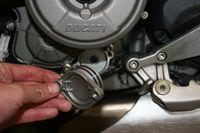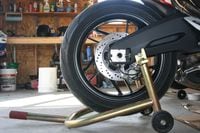Changing the oil in your motorcycle is about as basic as it gets, but for many riders, and especially new riders, grabbing a wrench and getting personal with their machine can be a source of anxiety they'd rather avoid. Riding a motorcycle is supposed to relieve stress, not the other way around. But with a little guidance, performing your own oil change can save you time and money, can be satisfying work, and can build your mechanical confidence as you familiarize yourself with your machine.
Not everyone is confident in the garage, and that’s okay. As a farmer, I spent a lot of time “fixing” broken-down rusty machinery. This usually involved wailing at the offending device with a mini sledge hammer (lovingly referred to as “The Persuader”) and issuing a flourish of expletives. These tactics—while amazingly effective on agricultural equipment originally built in the iron age—are ill-advised for modern motorcycles with tight manufacturing tolerances and fragile parts.
In college, Humanities majors are often required to take several basic math courses derisively nicknamed “math for poets” because they seem unnecessarily basic to anyone with a modicum of mathematical ability. This is the oil change for poets. The information below is intended to help you establish good habits in the garage and give you some confidence as you start wrenching.
If you've never changed your own oil, there's plenty of information out there, so this isn't a step-by-step guide. For that, check out this MC Garage video. Don't be afraid to talk to your mechanic or dealer if you run into any issues—that's what they're there for.
1) Do your reading. As my grandmother always said, "if you can read, you can cook." The same sentiment holds true in the garage. With so much information readily available, even daft farmers and poets can master an oil change with little stress. First, dig out your owner's manual and see what the manufacturer has to say. Usually, owner's manuals paint in broad strokes, but they're a good starting point to get specs and basic data. For more in-depth information, seek out the manufacturer's workshop manual for your bike. These are the same manuals professional mechanics use. They can be purchased from your dealer and often you can find them online. If you don't have confidence in your own abilities, workshop manuals go a long way in giving you crucial data for your bike, including torque specs, or instructions for finicky bodywork removal.
2) Be organized. Get a sheet of paper to make your own maintenance log. Use it to record specs and data from the workshop manual so you can refer to it at a glance. Also, write down what you did on the bike, the type and quantity of oil you used, and make any notes you'll want to remember next time. Also, just like a chef puts everything in its right place before starting to cook, you should organize tools and parts to have them close at hand. This includes putting a big sheet of cardboard under your bike in case of inevitable oil spills.
3) Use the right tools.
- If your bike has a canister-type oil filter, opt for a cap filter wrench from your auto parts store instead of a strap filter. While strap filters do the job, they don't always fit perfectly and can indent the delicate sides of a filter if you really torque it. Cap wrenches fit precisely and, used with your ratchet, make installing and removing filters a breeze.
- Invest in a torque wrench to ensure proper torque on bolts. Professional mechanics who change oil everyday can pretty much do it by feel, but for the rest of us, there's no shame in using a torque wrench, particularly for the drain plug, which if over-tightened can be stripped, requiring replacement of the entire drain pan.
- If you're bike doesn't have a center stand, consider getting a paddock stand to keep your bike level and secure. Once you have one, you'll use it all the time for adjusting your chain, removing the wheel for tire changes, elevating the bike for long-term storage, etc. We highly recommend Pit Bull stands, made in Huntsville, Alabama, by a guy who used to do work for NASA (really).
4) Be flexible. If it's your first time doing an oil change or you're doing it on a new bike, you may encounter some surprises. When I changed the oil for the first time on my used Ducati 996, I was surprised to learn that the center exhaust of the full Termignoni system prevented access to the drain plug. Removing the center exhaust pipe for the first time was a bit of a nuisance, but now, it's merely another step in the process.
5) Give yourself plenty of time. Chances are, the one socket you've misplaced from your set will be the one that you need. Give yourself enough time to account for any unforeseen trips to the hardware store.
6) Don't panic! If you finish changing the oil and a spot of oil starts to form under the bike, don't panic; it may be some used oil that got into some crevice and is leaking out. Don't go doubting yourself and over-tighten the drain plug or filter.
Featured Products:
For this oil change, we used Motorex Power Synt 10W 60. Motorex is based out of Langenthal Switzerland and exclusively makes products for motorcycles. The fully synthetic blend we opted for was designed specifically for sportbikes. If it's good enough for the Red Bull KTM MotoGP team (it's also used in all new KTMs from the factory), it'll be good enough for you.
For oil filters, we used products from Hiflo Filtro. The German company makes affordable filters that exceed typical OEM standards. They are readily available online or at your dealer.
Check out pit-bull.com for all your paddock stand needs. Designed and built in the USA, Pit Bull makes a stand for nearly every motorcycle. Go ahead and give them a call; their excellent customer service will help you get the right stand for your machine.











/cloudfront-us-east-1.images.arcpublishing.com/octane/6KMAHI27SKCO2JARFH2RSG7VAA.jpg)





/cloudfront-us-east-1.images.arcpublishing.com/octane/FZXHNOQRNVA3BIDWAF46TSX6I4.jpg)
/cloudfront-us-east-1.images.arcpublishing.com/octane/JRSFLB2645FVNOQAZCKC5LNJY4.jpg)
/cloudfront-us-east-1.images.arcpublishing.com/octane/ITNLTIU5QZARHO733XP4EBTNVE.jpg)
/cloudfront-us-east-1.images.arcpublishing.com/octane/VZZXJQ6U3FESFPZCBVXKFSUG4A.jpg)
/cloudfront-us-east-1.images.arcpublishing.com/octane/QCZEPHQAMRHZPLHTDJBIJVWL3M.jpg)
/cloudfront-us-east-1.images.arcpublishing.com/octane/HXOUJXQWA5HBHGRO3EMJIGFMVI.jpg)

/cloudfront-us-east-1.images.arcpublishing.com/octane/3TIWWRV4JBBOLDVGRYECVVTA7Y.jpg)
/cloudfront-us-east-1.images.arcpublishing.com/octane/KIX5O23D5NAIBGFXBN3327DKZU.jpg)
/cloudfront-us-east-1.images.arcpublishing.com/octane/7GJYDUIPXRGMTMQKN6ONYOLBOU.jpg)
/cloudfront-us-east-1.images.arcpublishing.com/octane/MUQLOVLL2ZDGFH25ILABNBXKTI.jpg)
/cloudfront-us-east-1.images.arcpublishing.com/octane/TNOU5DNE2BC57MFPMGN2EIDXAM.jpg)
/cloudfront-us-east-1.images.arcpublishing.com/octane/GTCXACQGJ5HAPDTGWUQKDEH44E.jpg)
/cloudfront-us-east-1.images.arcpublishing.com/octane/S35YGSEMEZB4BLTDJTSZPF4GLA.jpg)
/cloudfront-us-east-1.images.arcpublishing.com/octane/5UOT6HPX2JFMRJAX6EH45AR4MQ.jpg)
/cloudfront-us-east-1.images.arcpublishing.com/octane/OKWOJWAKP5EP3OACCRRWPCIX2Q.jpg)
/cloudfront-us-east-1.images.arcpublishing.com/octane/2WF3SCE3NFBQXLDNJM7KMXA45E.jpg)
/cloudfront-us-east-1.images.arcpublishing.com/octane/G4MG6OUCJNBSHIS2MVVOTPX65E.jpg)
/cloudfront-us-east-1.images.arcpublishing.com/octane/IIGGWFOTOJGB7DB6DGBXCCMTDY.jpg)
/cloudfront-us-east-1.images.arcpublishing.com/octane/QSTCM6AVEZA5JJBUXNIQ3DSOF4.jpg)
/cloudfront-us-east-1.images.arcpublishing.com/octane/U4I7G625B5DMLF2DVIJDFZVV6M.jpg)
/cloudfront-us-east-1.images.arcpublishing.com/octane/B6XD6LS6IVCQPIU6HXDJSM3FHY.jpg)
/cloudfront-us-east-1.images.arcpublishing.com/octane/ICL63FEDDRDTTMINYICCEYGMDA.jpg)
/cloudfront-us-east-1.images.arcpublishing.com/octane/FCGZHQXRBZFLBAPC5SDIQLVF4I.jpg)